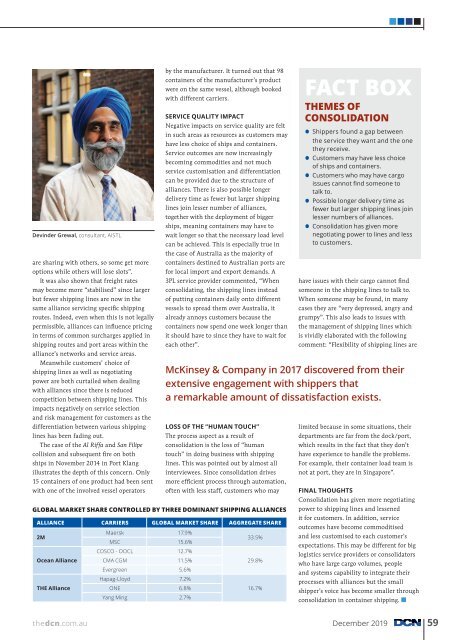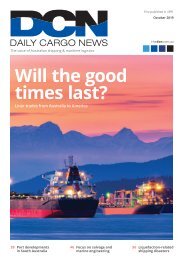DCN December Edition 2019
You also want an ePaper? Increase the reach of your titles
YUMPU automatically turns print PDFs into web optimized ePapers that Google loves.
Devinder Grewal, consultant, AISTL<br />
are sharing with others, so some get more<br />
options while others will lose slots”.<br />
It was also shown that freight rates<br />
may become more “stabilised” since larger<br />
but fewer shipping lines are now in the<br />
same alliance servicing specific shipping<br />
routes. Indeed, even when this is not legally<br />
permissible, alliances can influence pricing<br />
in terms of common surcharges applied in<br />
shipping routes and port areas within the<br />
alliance’s networks and service areas.<br />
Meanwhile customers’ choice of<br />
shipping lines as well as negotiating<br />
power are both curtailed when dealing<br />
with alliances since there is reduced<br />
competition between shipping lines. This<br />
impacts negatively on service selection<br />
and risk management for customers as the<br />
differentiation between various shipping<br />
lines has been fading out.<br />
The case of the Al Riffa and San Filipe<br />
collision and subsequent fire on both<br />
ships in November 2014 in Port Klang<br />
illustrates the depth of this concern. Only<br />
15 containers of one product had been sent<br />
with one of the involved vessel operators<br />
by the manufacturer. It turned out that 98<br />
containers of the manufacturer’s product<br />
were on the same vessel, although booked<br />
with different carriers.<br />
SERVICE QUALITY IMPACT<br />
Negative impacts on service quality are felt<br />
in such areas as resources as customers may<br />
have less choice of ships and containers.<br />
Service outcomes are now increasingly<br />
becoming commodities and not much<br />
service customisation and differentiation<br />
can be provided due to the structure of<br />
alliances. There is also possible longer<br />
delivery time as fewer but larger shipping<br />
lines join lesser number of alliances,<br />
together with the deployment of bigger<br />
ships, meaning containers may have to<br />
wait longer so that the necessary load level<br />
can be achieved. This is especially true in<br />
the case of Australia as the majority of<br />
containers destined to Australian ports are<br />
for local import and export demands. A<br />
3PL service provider commented, “When<br />
consolidating, the shipping lines instead<br />
of putting containers daily onto different<br />
vessels to spread them over Australia, it<br />
already annoys customers because the<br />
containers now spend one week longer than<br />
it should have to since they have to wait for<br />
each other”.<br />
LOSS OF THE “HUMAN TOUCH”<br />
The process aspect as a result of<br />
consolidation is the loss of “human<br />
touch” in doing business with shipping<br />
lines. This was pointed out by almost all<br />
interviewees. Since consolidation drives<br />
more efficient process through automation,<br />
often with less staff, customers who may<br />
ALLIANCE CARRIERS GLOBAL MARKET SHARE AGGREGATE SHARE<br />
2M<br />
Ocean Alliance<br />
THE Alliance<br />
Maersk 17.9%<br />
MSC 15.6%<br />
COSCO - OOCL 12.7%<br />
CMA CGM 11.5%<br />
Evergreen 5.6%<br />
Hapag-Lloyd 7.2%<br />
ONE 6.8%<br />
Yang Ming 2.7%<br />
FACT BOX<br />
THEMES OF<br />
CONSOLIDATION<br />
• Shippers found a gap between<br />
the service they want and the one<br />
they receive.<br />
•<br />
•<br />
Customers may have less choice<br />
of ships and containers.<br />
Customers who may have cargo<br />
issues cannot find someone to<br />
talk to.<br />
• Possible longer delivery time as<br />
fewer but larger shipping lines join<br />
lesser numbers of alliances.<br />
• Consolidation has given more<br />
negotiating power to lines and less<br />
to customers.<br />
McKinsey & Company in 2017 discovered from their<br />
extensive engagement with shippers that<br />
a remarkable amount of dissatisfaction exists.<br />
GLOBAL MARKET SHARE CONTROLLED BY THREE DOMINANT SHIPPING ALLIANCES<br />
33.5%<br />
29.8%<br />
16.7%<br />
have issues with their cargo cannot find<br />
someone in the shipping lines to talk to.<br />
When someone may be found, in many<br />
cases they are “very depressed, angry and<br />
grumpy”. This also leads to issues with<br />
the management of shipping lines which<br />
is vividly elaborated with the following<br />
comment: “Flexibility of shipping lines are<br />
limited because in some situations, their<br />
departments are far from the dock/port,<br />
which results in the fact that they don’t<br />
have experience to handle the problems.<br />
For example, their container load team is<br />
not at port, they are in Singapore”.<br />
FINAL THOUGHTS<br />
Consolidation has given more negotiating<br />
power to shipping lines and lessened<br />
it for customers. In addition, service<br />
outcomes have become commoditised<br />
and less customised to each customer’s<br />
expectations. This may be different for big<br />
logistics service providers or consolidators<br />
who have large cargo volumes, people<br />
and systems capability to integrate their<br />
processes with alliances but the small<br />
shipper’s voice has become smaller through<br />
consolidation in container shipping.<br />
thedcn.com.au <strong>December</strong> <strong>2019</strong> 59
















